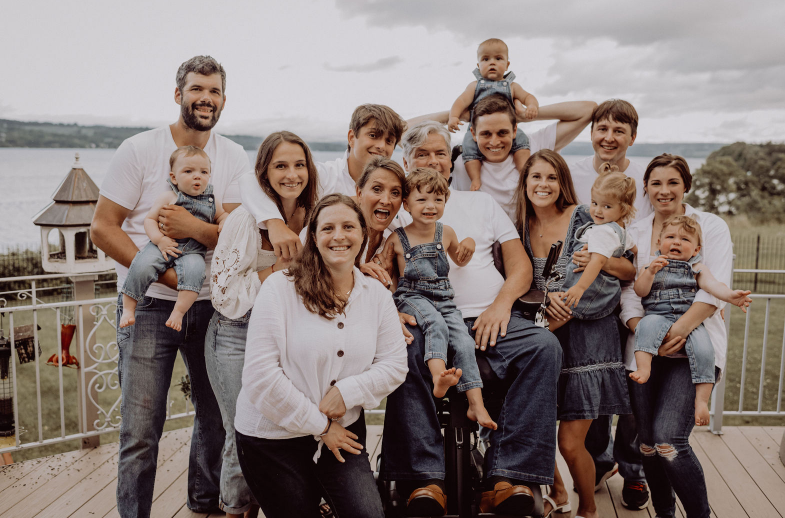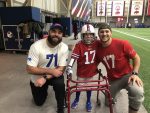Former NFL Player Tim Green Won’t Let ALS Define Him

Tim Green (center) with his wife, children, and grandchildren. (Photo by Jessica Green/Dani Moran Photography)
Once a first-round draft pick for the Atlanta Falcons, Tim Green now is battling another opponent — amyotrophic lateral sclerosis (ALS). The disease has left him unable to walk, speak, eat, drink, or breathe on his own, but he hasn’t let it obscure his positive outlook on life.
“I have been blessed beyond what I deserve, so when I look around me, it’s hard not to be filled with gratitude for my beautiful wife and our five wonderful kids and five amazing grandkids,” Green, 57, said in an email interview with ALS News Today, allowing him to formulate answers with his eye-tracking computer. “So I’ve almost become numb to the things I don’t have.”
After his eight-year professional football career ended in 1993, Green went on to become a TV commentator, lawyer, and best-selling author. He was diagnosed with ALS in 2016.

Tim Green with his wife Illysa Green. (Photo by Jessica Green/Dani Moran Photography)
For a defensive player in the NFL, where physical prowess won and lost games, focusing on his mind and what he can experience through that medium alone has helped him to cope with ALS.
“In one way, it’s excruciating,” Green said. “But I’ve had such a rich life that I have taken to reliving different moments from all the best experiences in my mind. And they are so vivid that I can actually taste a glass of my favorite red wine or feel myself plunge into the lake on a hot day.”
Even with the challenges of ALS, Green has continued to serve as a lawyer at the Barclay Damon firm in Syracuse, New York, and recently published his latest fictional children’s book, “Final Season,” which has parallels to his own life.
From player to author
In “Final Season,” the main character, Ben Redd, is a sixth-grade quarterback who is going through an internal struggle after learning his father has ALS. On one hand, his mother is pushing him to quit football, a career they believe caused his father’s ALS, but on the other, he wants to play for his father’s last season as coach.
The story is based on the experience of Green’s youngest son, Ty, now 15, who was playing football in middle school when Green was battling the earliest symptoms of ALS, such as loss of muscle strength and speech difficulties.
“Because it’s a middle-grade novel, it’s written from our 12-year-old son’s viewpoint,” Green said, “and how he copes with my physical deterioration and near-death because of ALS over the course of a football season where he and his friend are chasing after an elusive championship trophy.”
In real life, Green does believe his ALS is a result of repeated head injuries he sustained as a linebacker. In an interview with syracuse.com, he said it hasn’t changed his view on football and that the NFL is putting more emphasis on limiting head-to-head collisions.
Scientists have explored the link between ALS and head trauma from playing sports, including football, in a number of studies that have shown repeated blows to the head are associated with increased risk for developing neurodegenerative diseases such as Alzheimer’s disease, chronic traumatic encephalopathy, and ALS. A 2016 study, which exposed rats with the human SOD1 mutation, which models familial ALS, to mild traumatic brain injuries once per week for two or five weeks, found that those exposed to more traumatic brain injuries had earlier-onset ALS symptoms.
“Final Season” is not the first of Green’s children’s books. He partnered with retired baseball player Derek Jeter to write a series of “Baseball Genius” books, in which a young boy helps a New York Yankees star improve his batting average. The first of the three-book series was published in 2018.
For now, Green has pivoted genres. He’s halfway done with a memoir that mixes memories from his past as an NFL player and broadcast talent and what he’s learned in his battle with ALS.
“It’s about the times I had near-misses with fame,” Green said, listing off interactions with famous people such as Bill Parcells, two-time Super Bowl-winning coach of the New York Giants; Rupert Murdoch, billionaire media businessman; Joe Buck, award-winning broadcaster; and Kathy Lee Gifford, 11-year host of NBC’s “Today” show. “These stories are interspersed with snapshots of my ALS story from my perspective.”
Nonprofit work
In addition to being an author and lawyer, Green has focused much of his effort on his nonprofit, Tackle ALS, which so far has raised more than $5.3 million for the Sean M. Healey and AMG Center for ALS. The existing multidisciplinary clinic at Massachusetts General Hospital was expanded to include a research arm and renamed in 2018.
“Most of the money has come from friends, whether by their own contributions or from fundraising,” Green said. “I really appreciate the people who don’t know me but want to simply fight the disease.”
The center’s research arm is focused on adaptive platform trials, which allow for certain changes in trial protocol, such as enrollment criteria and the design of the trial itself, throughout the study period. It also allows multiple interventions to be tested at the same time.
In collaboration with Tackle ALS, the center earlier this year launched the HEALEY ALS Platform Trial, which recently completed enrollment in two of its arms, verdiperstat and CNM-Au8, and is evaluating the safety and effectiveness of two other investigational treatments, zilucoplan and pridopidine. It was announced in September that SLS-005 (trehalose) was cleared to be added to the trial (NCT04297683) as a fifth experimental treatment.
The first patient was enrolled in July 2020. Merit Cudkowicz, MD, the center’s director, said such a quick turnaround would not have been possible without financial assistance from Tackle ALS or Sean M. Healey, who died from ALS in 2020.
“Most groups that try to do platform trials, they can spend three or four years designing and trying to fundraise it, trying to convince companies to use it,” Cudkowicz told ALS News Today by phone. “If we hadn’t had Tackle ALS and the Healey AMG funds, we could still be talking about the platform trial now and not actually like having it up and running and almost done and rolling.”
The center also includes a multidisciplinary clinic that Green attends. He believes being treated at the Sean M. Healey and AMG Center for ALS slowed the disease’s progression and improved his quality of life.
“Many studies have now shown people have a better quality of life and live longer … [when they] go to these multidisciplinary centers,” Cudkowicz said. “I think that’s because you can be very proactive about breathing and nutrition and physical therapy, so that all really does work.”
Green has been taking Radicava (edaravone), which he believes also has slowed the disease’s advancement.
That treatment, combined with quality care, is helping propel him forward, allowing him “to fight back hard against ALS and live my life to the fullest,” he said.
People around him are seeing that, too.
“I’m just struck by how he is living with ALS,” Cudkowicz said. “He really is living and doing the things he cares about and helping others while he’s doing it.”







